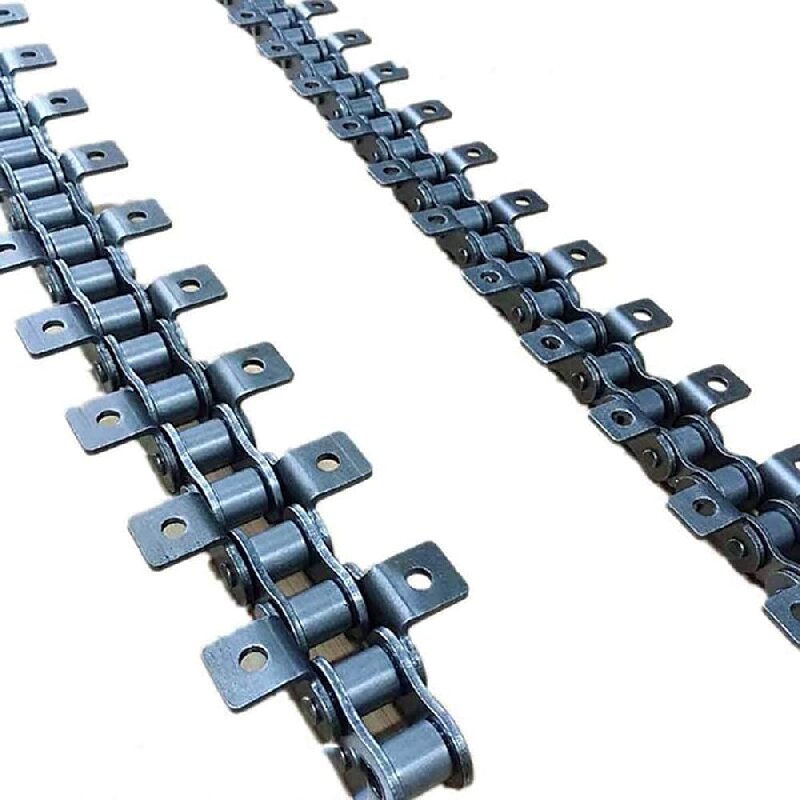Conveyor chains play a critical role in material handling across various industries, including manufacturing, logistics, and mining. However, frequent wear and tear can lead to costly breakdowns and production downtime. To maximize conveyor chain life, proper selection, installation, and maintenance are essential. Below are the best practices for increasing conveyor chain longevity.

Stainless Steel Conveyor Chain Production Line Video: https://www.youtube.com/shorts/2ojX8M68npE
1. Select the Right Conveyor Chain for the Application
Choosing the correct type of conveyor chain for your specific application is the first step in prolonging its life. Consider the following factors:
Load capacity: Ensure the chain can handle the required weight without excessive strain.
Material compatibility: Use corrosion-resistant materials (e.g., stainless steel, nickel-plated, or polymer chains) in harsh environments.
Speed and operating conditions: Select chains designed for the speed and temperature conditions of your application.
2. Proper Installation and Alignment
Incorrect installation and misalignment are primary causes of premature chain failure. To avoid these issues:
Ensure sprockets and shafts are properly aligned to prevent uneven stress on the chain.
Maintain proper chain tension; excessive tension accelerates wear, while too little tension can cause chain jumping.
Use high-quality sprockets that match the chain size and type for smooth operation.
3. Regular Lubrication and Proper Lubricant Selection
Friction is one of the leading causes of conveyor chain wear. Proper lubrication can:
Reduce wear and minimize friction between chain links and sprockets.
Prevent corrosion, especially in humid or chemically reactive environments.
Improve overall efficiency and reduce energy consumption.
Best Practices for Lubrication:
Use the correct type of lubricant for your operating conditions (e.g., high-temperature or food-grade lubricants if required).
Apply lubrication at the right intervals, preferably using automatic lubrication systems for consistency.
Avoid over-lubrication, which can attract dust and contaminants, leading to buildup and accelerated wear.
4. Keep the Chain and Surrounding Area Clean
Dust, dirt, and debris accumulation can cause premature wear and chain jamming. To prevent this:
Regularly clean the conveyor chain using compressed air or a suitable cleaning solution.
Install protective covers or enclosures if the chain operates in a dirty environment.
Remove any material buildup on the sprockets or rollers to ensure smooth operation.
5. Monitor Chain Wear and Replace Worn Components
Perform routine visual inspections and monitor the following signs of wear:
Elongation: Chains stretch over time, which can lead to poor engagement with sprockets.
Roller or pin wear: Excessive wear on pins or rollers can cause chain failure.
Cracks or corrosion: Any structural damage indicates the need for immediate replacement.
Pro Tip: Use wear indicators or chain elongation gauges to measure chain stretch and replace chains before failure occurs.
6. Ensure Proper Load Distribution
Uneven load distribution can put excessive stress on certain chain links, leading to premature failure. To improve load distribution:
Avoid overloading the conveyor beyond its rated capacity.
Use idler sprockets or chain guides to distribute tension more evenly.
If possible, redesign the conveyor layout to reduce stress points and minimize shock loading.
7. Use High-Quality Conveyor Components
The lifespan of a conveyor chain is closely linked to the quality of its components. To enhance durability:
Invest in high-quality sprockets that match the chain type and are resistant to wear.
Use hardened pins and bushings for better strength and longevity.
Consider sealed bearing rollers to reduce maintenance needs and enhance efficiency.
8. Implement Predictive Maintenance Strategies
Instead of waiting for failures to occur, adopt predictive maintenance techniques to detect wear early.
Use vibration analysis to monitor chain performance.
Implement temperature monitoring to detect overheating due to friction or misalignment.
Utilize automated monitoring systems to track chain elongation and detect potential failures before they happen.
9. Control Operating Temperature and Environmental Conditions
Extreme temperatures, moisture, and chemical exposure can degrade chains quickly. To extend chain life:
Use heat-resistant or corrosion-resistant chains for high-temperature or humid environments.
Protect chains from excessive exposure to water, chemicals, or abrasive materials.
Ensure proper ventilation and cooling in hot environments to prevent overheating.
Conclusion
By selecting the right chain, ensuring proper installation, maintaining adequate lubrication, and adopting a proactive maintenance strategy, you can significantly increase the lifespan of your conveyor chains. Regular monitoring, proper load distribution, and environmental protection will further help in reducing downtime and minimizing operational costs.
By following these best practices, industries can achieve smoother operations, fewer breakdowns, and long-term cost savings in conveyor chain maintenance.
GIDI CHAIN LIMITED supply lots of roller chain, conveyor chain, Leaf Chain, welded chain, forged chain, Palm Oil Mill Chain, Hoisting Chain,Mine and Metallurgy Chain, etc. totaling over 3000 varieties. and 90% of chains are exported to worldwide, Which mainly export to Southeast Asia, European, North America, South America. Chains are welcomed by customers with the excellent quality. Our company owns more than 100 sets of advanced and professional manufacturing equipment, Perfect and rigorous QC system is implemented in every process from material purchasing to finished products packaging. Also, we have passed the ISO9001: 2015 Quality Management System Certification.
More Detail : www.gidi-chain.com
